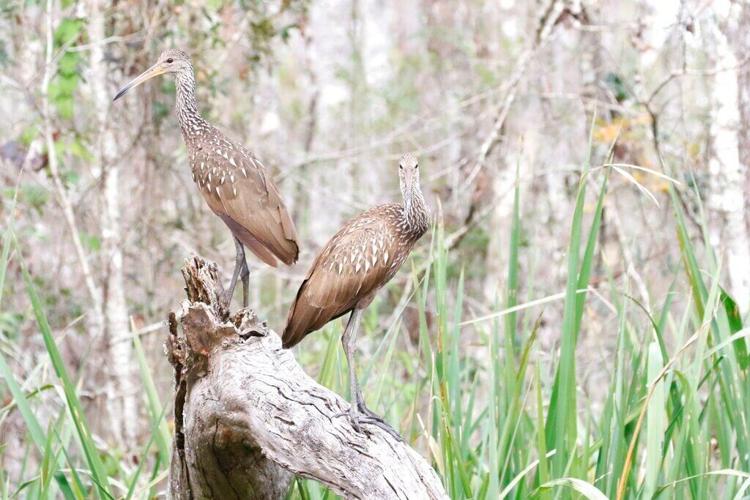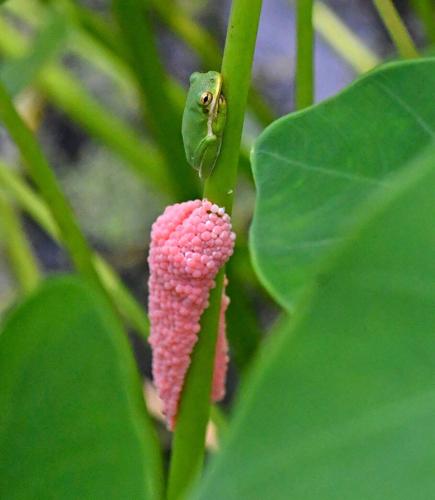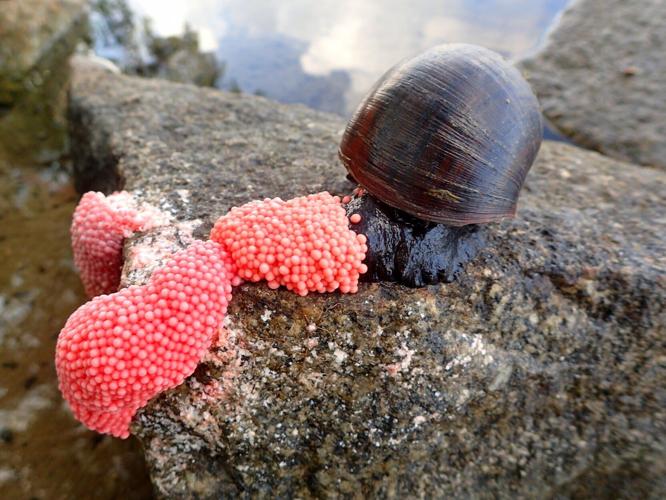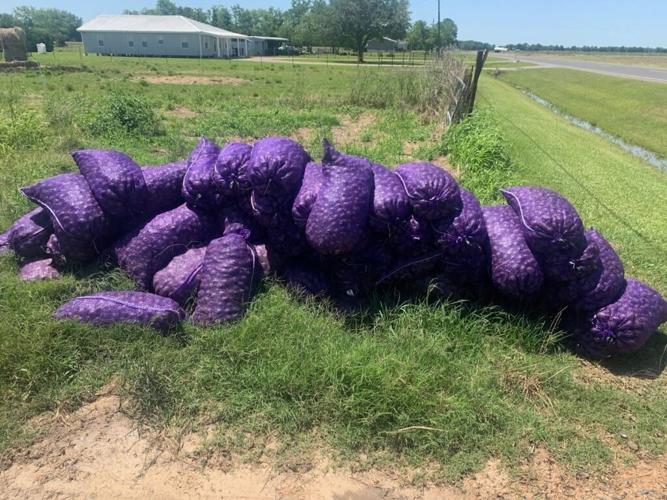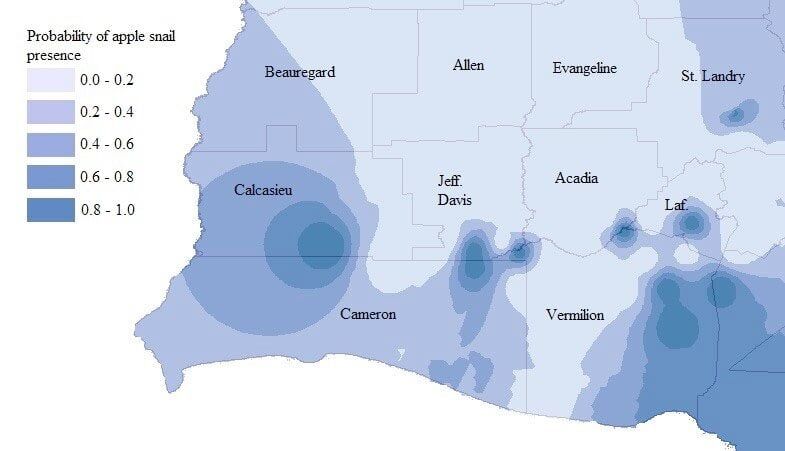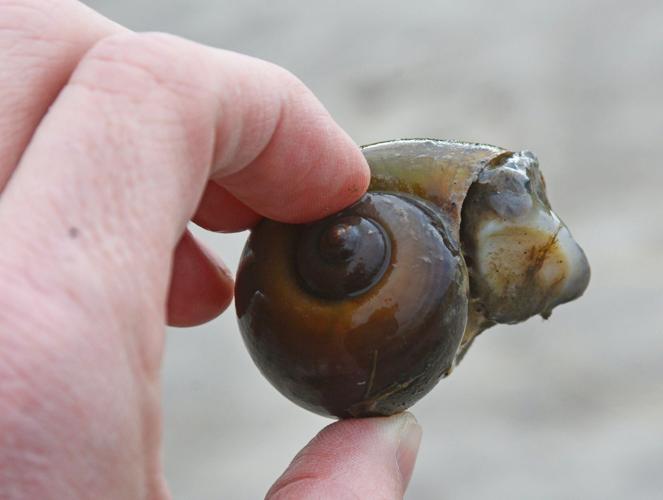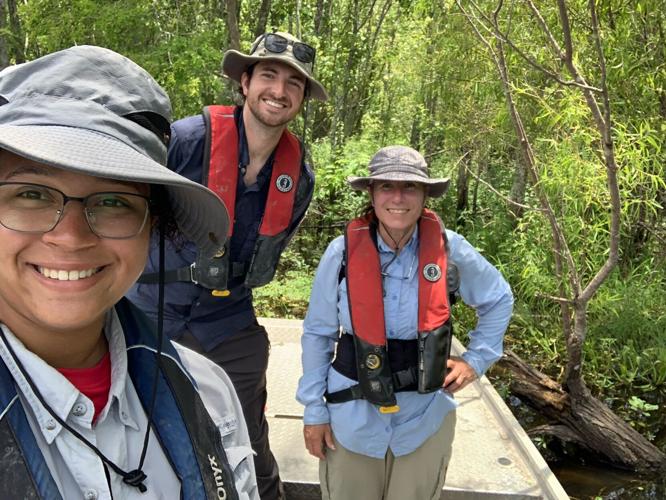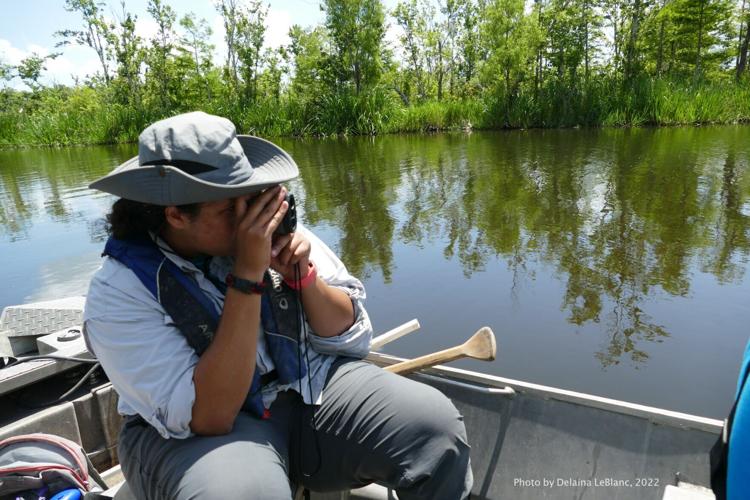It's not a colorful or elegant bird, nor does it sing anything that could be described as pleasant. Its feathers are drab. Its beak droopy, and its long-legged gait is so gimpy that it was cursed with one of the most disparaging names in all of birddom: the limpkin.
And yet the limpkin’s first appearance in Louisiana a few years ago was cause for celebration. That’s because this gangly, shrieking bird from Florida is the mortal enemy of a foreign snail that’s been wreaking havoc in Louisiana’s farms and wetlands.
“It was surprising and wondrous when it emerged,” said Delaina LeBlanc, the migratory bird coordinator for the Barataria-Terrebonne National Estuary Program. “They’re very exciting because they’re a bio-control for an invasive species that’s been causing a lot of problems here.”

An apple snail lays a cluster of bright pink eggs. The snail is an invasive species that's causing trouble in Louisiana wetlands and farms. Flickr/Ravenblack7575
LeBlanc and Nicholls State University scientists recently completed the first Louisiana limpkin population census, counting 164 limpkins in Terrebonne, Lafourche and St. Mary parishes. It may be a small snapshot of the bird’s numbers, but it’s a clear indication the birds aren’t just visiting.
“It really looks like the limpkins are getting a foothold here,” said Robert Dobbs, a Louisiana Department of Wildlife and Fisheries ornithologist. “They generally don’t persist in places well outside their core range. It’s possible we had some birds wandering around they happened on Terrebonne-Lafourche, which is full of apple snails. So why leave? There’s a ton of food.”
Based on the census and a growing number of limpkin sightings in New Orleans, Baton Rouge, Lake Charles and other parts of the state, the total population could be as high as 10,000, according to Erik Johnson, the conservation science director for the National Audubon Society’s Delta chapter.
Louisiana’s “ridiculous abundance” of apple snails means that number is likely to keep growing, he added.
Native to South America, the apple snail arrived in Louisiana, likely as an aquarium escapee, several years ahead of limpkins. Slow as they are, the baseball-sized gastropods have managed to overpopulate waterways across the state, eating up plants that provide food and habitat for native fish, birds and other wildlife.

The Louisiana limpkin census team in 2022.
They also recently started oozing into farms that produce two of Louisiana's favorite foods: rice and crawfish. They’ve consumed the entire crop at some rice fields, and clogged up so many crawfish traps that farmers have had to halt harvests and drain their ponds early.
Limpkins are built for snail hunting. Their long, crane-like legs allow them to wade into wetlands where snails congregate, and their long, strong bills have a right-side curve that matches the interior contours of a snail’s shell. A gap at the bill’s end allows the bird to tweezer out the snail’s slimy body.
The limpkin gets its name from its limpy gait, but it's also known as the "crying bird" for its distinctive screech. Some people have mistaken it for the cries of a murder victim.
LeBlanc plays a limpkin audio clip that sounds like a cat in heat.
“Only shriller,” she adds.
Mostly found in tropical climates, limpkins may be leaving Florida because the state’s native apple snail is in sharp decline due to habitat loss, pollution and bouts of extreme weather.
The first sighting of a limpkin in Louisiana was in December 2017 at snail-infested Lake Boeuf near Thibodaux. A month later, a birder spotted two more limpkins near a busy road near Houma, touching off a rush of bird enthusiasts hoping to get a view of the welcome strangers.
The limpkins “put on quite a show,” shrieking and gobbling snails and sharing their leftovers with each other, Johnson said. The show also included the naughty stuff birders really wanted to see.
“A few lucky observers also witnessed copulation,” he said.
Nests were made and eggs were hatched. One particularly successful family produced seven fuzzy little hatchlings, which Johnson nicknamed "floof-kins."
The growing and apparently permanent limpkin population led LeBlanc to launch Louisiana’s first limpkin census during the summer of 2022. With funding support from the Environmental Protection Agency, LeBlanc and Nicholls graduate students set out on boats across the three parishes, stopping at regular intervals to play recordings of limpkin calls to draw the birds out. At one survey spot, they counted 40 limpkins minutes after hopping in their boat.

Sacks of apple snails pile up at a Louisiana crawfish farm near Welsh, La.
While limpkins don’t appear to have a downside, LeBlanc notes that there could be trouble ahead if the birds start eating other critters. If snails aren’t available, limpkins will dine on lizards, frogs and shellfish. Of particular concern are the Louisiana pigtoe and three other native freshwater mussel species that are teetering on the brink of extinction, and might make tasty limpkin treats.
But it doesn’t appear the apple snail will fade from the Louisiana landscape anytime soon.
“Even if there’s a freeze that kills a lot of them (the apple snail), a female can lay 500 to 700 eggs at a time,” LeBlanc said. “They bounce back pretty quickly.”
The snails stay below the water's surface and aren’t often seen, but clusters of their bubblegum pink eggs are hard to miss and have become an all-too-common sight on tree trunks and pilings just above the water line.
They’ve been known to wipe out rice fields of 40 acres or more. At crawfish farms, they're attracted by baits placed in crawfish traps. So many snails crowd in that little room is left for crawfish.

Apple snail eggs line a branch as it emerges from the surface of a pond at the Lamar Dixon Expo Gonzales, La.
“In some cases, farmers are catching as many apple snails as crawfish,” said Blake Wilson, a Louisiana State University AgCenter researcher.
Apple snails are edible but sometimes carry rat lungworm, a parasite that can be fatal for humans and other mammals.
Limpkins won’t be able to stop the apple snail problem on their own, but they’re making a big — and growing — dent, LeBlanc said.
At Lake Boeuf, waterfowl and aquatic plants started disappearing after the apple snail appeared.
“It was so bad that there were no ducks for a few years,” LeBlanc said. "They had nothing to eat."

An apple snail from a crawfish pond near Rayne.
But then a few dozen limpkins swooped in and started gorging on escargot.
“And by this last Christmas, the ducks and grasses had come back in the lake,” she said. “It was amazing.”
LeBlanc hopes to continue tracking the limpkin’s spread and any changes in their diet with the help of Louisiana residents. Anyone who sees a limpkin eating anything other than an apple snail is asked to snap a photo and email it to her at dlaina@btnep.org.
“Limpkins are exciting, and there’s a lot we still need to learn,” she said.
Want to hear a limpkin's Banshee wail? Check out this Audubon recording.

